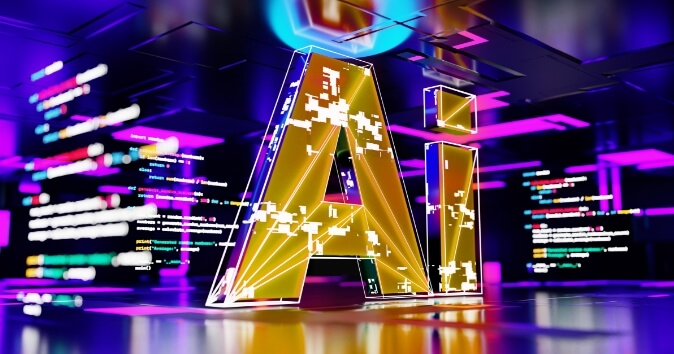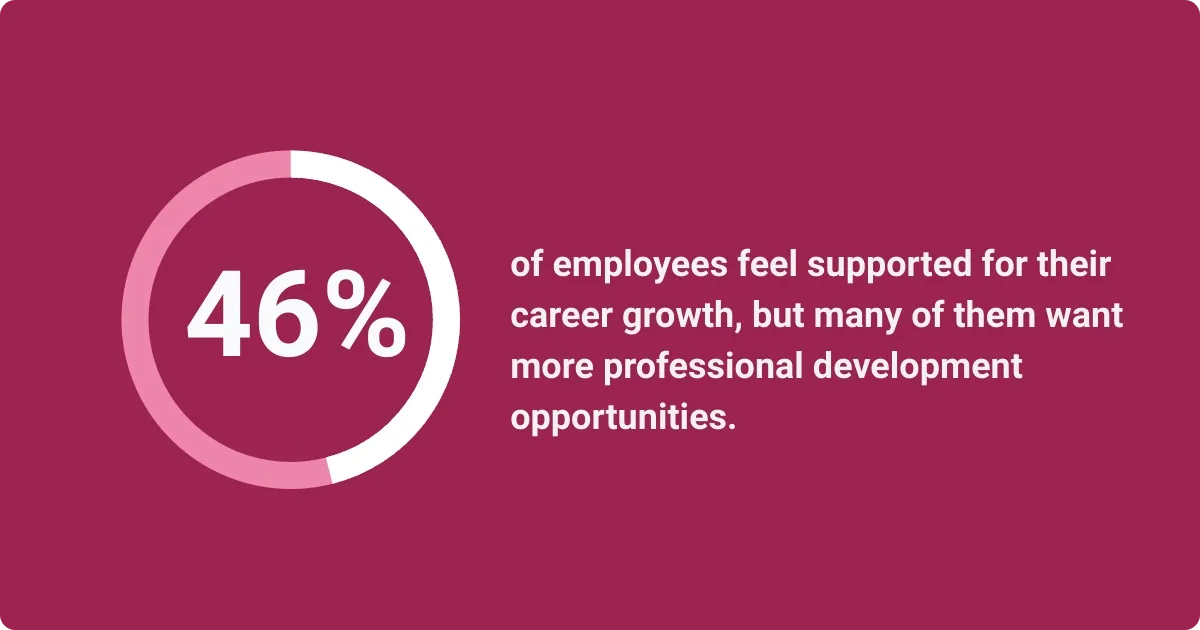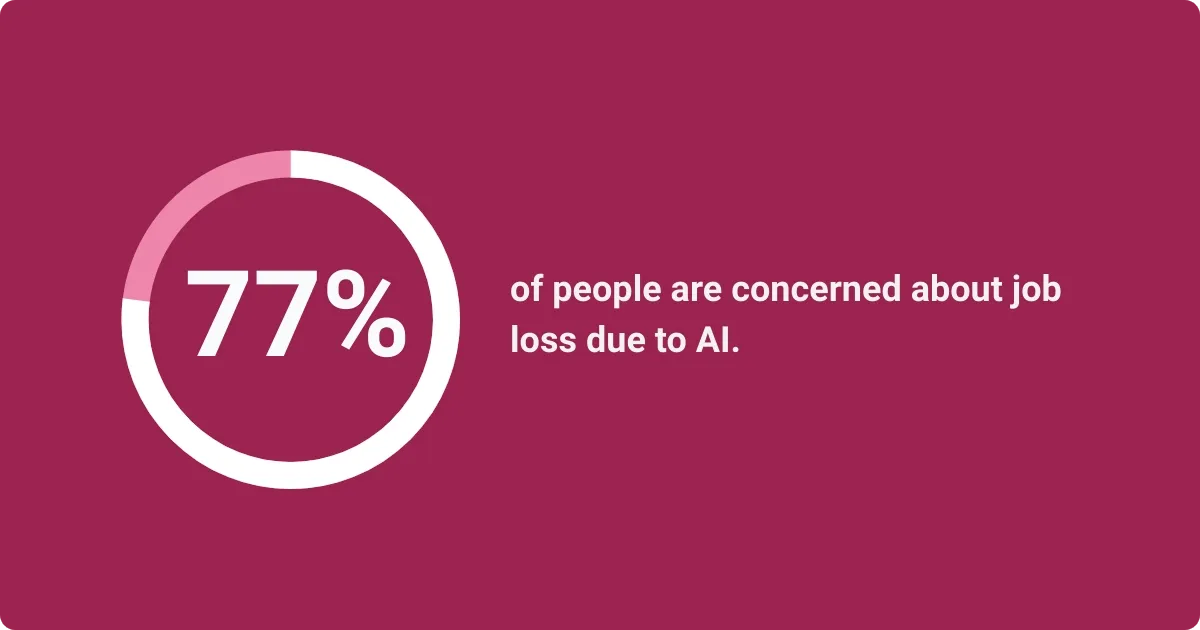Harnessing AI in the Workplace: Driving Productivity and Innovation
Table of contents

The artificial intelligence (AI) market will expand to well over $826 billion by 2030, according to Statista's "Artificial intelligence (AI) market size worldwide from 2020 to 2030" report. AI has found its way to all industries, from finance and healthcare to transportation and manufacturing. Companies adopting AI are seeing a surge in employee productivity that can fuel a company's performance and profits.
According to three separate studiesOpens in a new tab, AI boosts employee productivity by 66%. Adopting AI is no longer just for tech-savvy early adopters – it's a business necessity if you want to stay competitive.
As the technology improves, the impact of AI in the workplace will grow, too. Understanding how AI can affect your team and business can help you implement the right tools to unlock productivity and retain top talent.
How is AI being used in the workplace?
AI technology is changing the culture in the workplace by transforming practically every aspect of daily workflows. Here are some common use cases:
Automation of routine tasks
One of the biggest benefits of using AI at work is its ability to handle repetitive, time-consuming tasks that have traditionally bogged teams down. This frees up time and bandwidth and lets teams focus on creative and strategic tasks. Workhuman CEO Eric Mosley calls AI a "time machine," not one that moves companies through time, but rather one that creates time.
In finance, for example, AI can take over data entry and fraud detection, while in healthcare, it automates patient records and appointment scheduling. This helps reduce manual data monitoring, human errors, and resource use.
Employees have more time for high-impact activities that benefit from their real-world experience and unique skills, which leads to more job satisfaction and higher productivity.
Simply put, AI helps you shift the workplace dynamic and create more fulfilling roles for employees.
Incorporating machine learning into decision-making systems
The amount of data companies collect daily, let alone yearly, has grown to astronomical levels. AI is the only tool that can process these large datasets in a fraction of the time it would take employees to do so.
While processing data, AI can also uncover trends and patterns within seconds and provide deep insights that human analysis might miss. AI-powered business intelligence can even provide predictive analytics that allows you to adapt to market shifts or future needs before they become issues. With AI, you get data-driven recommendations that help you make better decisions.
AI in talent acquisition and workforce management
AI can reduce the time needed for employee acquisition and help you get highly qualified talent on your team. By analyzing hundreds of applications using specific keywords, AI narrows down the list of potential candidates for you and gives predictions on candidate success based on job requirements.
By focusing on data, AI also helps remove bias from the recruitment process, helping you build a more diverse and inclusive workforce. That helps your company find the best person for the job, leading to a better fit between employees and their roles and improved retention.
After you've hired an employee, you can also use AI to spot contributions and areas for growth. Based on the gathered data, your AI tools will create a tailored training path to improve an employee's hard and soft skills.
According to a September 2023 Gartner survey of 3,500 employees, only 46% of employees feel supported for their career growth, but many of them want more professional development opportunities. With AI, you can bridge this gap and motivate employees with specialized education. Providing training like this helps employees feel more valued and satisfied in their jobs, promoting retention.

Human Intelligence™ gives you unparalleled talent insights from skills mapping, mentor matching, and team building.
Drive performance with data analysis sourced directly from the rich human data of your employees’ peer-to-peer recognition. The AI AssistantOpens in a new tab makes it easy to find leaders, high performers, and mentors or you can dig deeper into skills and team insights with Workhuman iQOpens in a new tab dashboards.
AI in customer service
AI-powered chatbots and AI virtual assistants are transforming customer service by automating relevant and educational answers to common customer questions. Using natural language processing (NLP), chatbots can understand and respond to customers like a human would, giving you a 24-hour-a-day, seven-day-a-week employee for customer service.
AI in collaboration and connectivity
Teams had to manually organize schedules and transcribe meetings in real-time before AI. Now, AI platforms automatically sync team member schedules without back-and-forth emails and provide digital meeting transcriptions that include multiple speakers.
With the help of AI, your team members can stay informed on company updates or changes to processes even when they're globally dispersed.
Benefits of using artificial intelligence in the workplace
Now, let's see how all the AI uses above can impact your organization:
1. Cost savings
AI streamlines workflows by taking care of extra manual work, reducing errors, and completing tasks faster. This contributes to operational efficiency and, ultimately, positively impacts the bottom line.
AI's ability to take over repetitive manual tasks cuts labor costs and allows employees to focus on high-value tasks, increasing productivity and satisfaction. Highly productive and satisfied employees will better meet business goals and stay with a company longer, which reduces talent acquisition costs, too.
2. Increased flexibility
AI helps you identify pain points and hidden opportunities to improve employee relationships and create inclusive work environments.
Building a supportive and good company culture is more challenging for companies with hybrid or remote teams, where in-person interactions are limited or non-existent. AI can help you maintain culture in a hybrid workplace by streamlining communications and spotting trends in employee data, such as issues with collaboration, wellbeing, and satisfaction.
AI helps keep everyone connected and on the same track toward company goals. In the office, it analyzes office usage patterns and employee preferences to make better use of physical spaces and allocate desks or book meeting rooms based on demand.
3. Managing worker wellbeing
AI digital platforms allow employers to recognize employees' contributions more easily and keep morale high. They gather insights from employee pulse surveys and offer real-time feedback so managers can act quickly to boost employee wellbeing and engagement.
AI automatically logs important milestones and sends reminders to individuals so they can reach out on time. The goal is to foster an engaged culture by checking in with employees consistently and letting them tell you when they need to talk. Creating a more engaged culture helps employees feel more satisfied and leads to a more positive work atmosphere.
AI's impact on leadership and management
Using AI in management enables the collection of critical data on employee performance, engagement levels, and satisfaction. By analyzing this data, leaders can detect patterns and identify areas where employees require additional support, allowing for targeted interventions.
This proactive approach fosters a more engaged and motivated workforce. Through AI-driven insights, management can make informed decisions that contribute to a positive and productive work environment.
See also: Artificial Intelligence and Leadership
Examples of AI technologies in the workplace
Here are some tangible examples of how companies are using AI tools within the workplace:
AI-powered chatbots
For customer-facing roles, chatbots provide support to customers around the clock and can handle a high volume of inquiries. In an industry like healthcare, chatbots help patients schedule appointments and answer common medical questions, freeing up staff time.
Chatbots also help employees reduce bottlenecks and increase productivity. Internally, tools like Slack have AI chatbots that deal with HR requests like time off, schedule adjustments, and benefits, allowing employees to check their paid-time-off (PTO) balances and other crucial information.
AI-driven office sensors
In hybrid and in-person work environments, AI-driven office sensors continuously monitor and optimize office conditions. Smart sensors can track room occupancy or adjust the lighting and temperature based on real-time usage. This ensures a comfortable environment for all occupants while saving energy, time, and effort.
AI sensors can also track foot traffic, air quality, and noise levels to give managers a full understanding of how a space is being used. This information lets them identify opportunities for maximizing space and operational efficiency.
AI in predictive maintenance
By constantly monitoring all your equipment and tools, AI can quickly spot any slight change in performance and notify your team about possible breakdowns before they happen. It can detect patterns that signal common failures and schedule repairs in advance to minimize downtime for your team.
For example, airlines use this type of technology to assess the condition of engines and minimize delays for passengers. Predictive maintenance also extends the life of machines and keeps everyone safe from unexpected failures, helping to create a culture of safety.
See also: AI and the Future of Work: How Emerging Technologies Are Reshaping the Workforce
Addressing AI risks in the workplace
Despite its many benefits, the power and scale of AI are unprecedented, so you need a strategy that mitigates any risks and builds a plan for various scenarios. These are some common concerns to address:
Job displacement concerns
The amount of labor AI can perform makes job displacement concerns valid. A Forbes Advisor survey found that roughly 77% of people are concerned about job loss due to AI.

To relieve this worry, try focusing on the potential of reskilling the workforce to build future-proof career value. Investing in employees' futures will help prepare them for the AI transition and make them feel cared for.
You should also steer employees to develop creative thinking, problem-solving, and technical skills beyond AI's abilities. Training employees in client relations or design thinking will allow them to thrive as AI becomes more prominent at work.
Data privacy and security risks
AI presents new opportunities for malicious actors to access and compromise data. Hackers can use AI to generate malware that evades detection, so your top priority should be building robust data security protocols, establishing ethical policies and guidelines, and enhancing transparency. Implementing encryption, access controls, and other security measures will tighten up your security.
You also must confirm that your AI system complies with all relevant privacy regulations like the General Data Protection Regulation (GDPR) or the Health Insurance Portability and Accountability Act (HIPAA). That way, you can protect your customers' data.
Ethical concerns of AI decision-making
AI tools can only analyze the data we give it. We all have inherent biases, and these are often reflected in the data we use to train AI. To address this, prioritize thoughtfulness and transparency when using AI. Explain to employees and customers how AI drives decisions and inform them of regular audits the company performs to identify issues.
Adapting to an AI-driven workplace
Follow these steps to adopt AI in the workplace and reap its many benefits, such as:
Upskilling and reskilling the workforce
AI is still a relatively new technology, so many of your employees will not have the necessary AI skills. They will require initial and ongoing training to understand how to utilize AI tools and navigate how these tools might change their job roles.
For example, Amazon's Upskilling 2025 program gives employees training in both tech and essential soft skills like project management to prepare them for future career growth. Another successful example is IBM's SkillBuild program, which helps employees learn coding and analytical thinking.
Building a culture of innovation
Being clear that AI is a tool that will create opportunities rather than disruption will help foster a culture of innovation within your company. Promote generative AI as a tool for enhancing – not replacing – human capabilities.
Workhuman iQ® and the AI Assistant are the HR industry's first and only tools to mine the rich, human data of recognition programs to surface Human Intelligence. With Human Intelligence insights, your teams can monitor and measure recognition program performance, employee skills, people dynamics, and more. Managers can get a full look at how employees fit into your organization and the value they bring toward driving growth.
Change management for AI integration
Effective communication is the first step to integrating AI into the workplace. Explain with full transparency how AI will benefit the company and the employees. Don't be afraid to address common concerns about job security.
Be active in the adoption process instead of relying on employees to do all the heavy lifting. When you experience resistance, offer more support, like hands-on training sessions or mentor and mentee programs. This is your chance to understand your employees and build more trust.
Leading with AI in your workplace
AI has the power to completely transform your workplace by automating tasks, gathering and analyzing data, predicting trends, and more. All this helps improve innovation, productivity, job satisfaction, and performance.
Although adopting AI in the workplace is not without risks, addressing problems head-on will help avoid them. Being proactive about change management and employee education will help employees understand how using AI in project management will benefit them and how to implement it into their workflows.
As AI technology advances, the future will likely bring even more sophisticated tools that further integrate into daily business operations. Companies that harness these advancements will find themselves at the forefront of innovation, leveraging AI for strategic insights and competitive advantage.
To stay ahead of the competition, organizations should invest in continuous AI training for their workforce, foster a culture of innovation, and remain agile in adapting to new AI capabilities.
About the author
Maeve Ginsberg
A wellness enthusiast and the mid-day walk’s #1 fan, Maeve champions work-life balance.
Having gone from a corporate job to self employment, Maeve has lived through countless working styles. This evolution forced confrontation of her own limiting beliefs, eventually breeding a completely individualized approach to work and productivity.
As a Senior Copywriter, Maeve often writes on workplace wellbeing and strives to advocate for all workers and leaders to find small yet significant ways to make their work lives healthier and more fulfilling.
Offline, Maeve enjoys testing new cuisines and hanging upside down off walls (also known as bouldering).